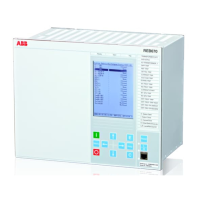EQUATION1110 V1 EN-US (Equation 21)
where:
k is a constant, which depends on the type of ASCT
(that is, k=1, for 1/1A ASCT or k=5 for 5/1A ASCT or k=2 for 2/1A ASCT).
The well-known relationship, between positive, negative and zero sequence current
components and individual phase current quantities is shown in Equation
22:
1
2
2
2
0
1 1 1
1
1
IA I
IB a a I
IC a a I
= ×
é ù é ù é ù
ê ú ê ú ê ú
ê ú ê ú ê ú
ê ú ê ú ê ú
ë û ë û ë û
EQUATION1788-ANSI V1 EN-US (Equation 22)
where:
a is complex constant (that is, a=-0.5+j0.866).
By including Equation
19, Equation 20, Equation 21 and Equation 22 into the
Equation 18 the equation for the series-connected, ASCT secondary current (that is,
summated current) can be derived according to equation 23:
I
SUMM
1
k
---
I
1
e
-j30°
× I
2
e
j30°
× 2 3 I
0
× ×+ +( )×=
EQUATION1114 V1 EN-US (Equation 23)
From Equation 23 it is obvious that the ASCT rated ratio is declared for balanced three
phase current system, when only positive sequence current component exist. For any
unbalanced condition (that is, external or internal fault), both negative and zero
sequence current components will give their own contribution to the summated current.
Section 6 1MRK 505 370-UUS A
Differential protection
174 Busbar protection REB670 2.2 ANSI
Application manual

